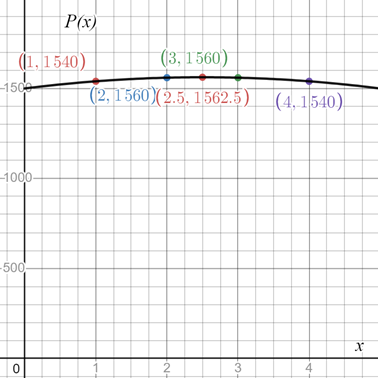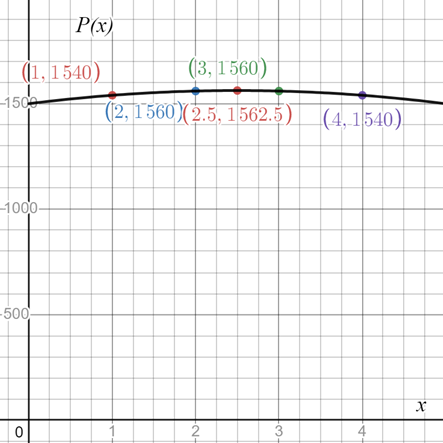
Concept explainers
a.
To write: The verbal model and a quadratic function that represents the weekly profit of the theater.
Verbal model:
Quadratic model:
Given information:
The theater sells 150 tickets to a play weekly when the price is $20, and for each $1 decrease in the price, the sale increases by 10 tickets per week.
Concept used:
Profit = Revenue − cost
Calculation:
Since the profit revenue minus total cost, the verbal model for the theater’s profit can be given as:
Let the price be decreased
So, the price of the ticket becomes
Then, the revenue will be
Therefore, the function modelling the situation can be written as follows:
b.
To make: A table of values for the quadratic function.
Given information:
The theater sells 150 tickets to a play weekly when the price is $20, and for each $1 decrease in the price, the sale increases by 10 tickets per week.
Concept used:
Take a random value of x and substitute in the function to find the value of y, and then use the pair of points to make the table.
Calculation:
The quadratic function for the situation is
When
When
When
When
Now, construct the table based on these values.
c.
To graph and find: The graph of the quadratic function using the table and then find how the theater can maximize the profit.

The theater can maximize the profit offering each ticket for
Given information:
The theater sells 150 tickets to a play weekly when the price is $20, and for each $1 decrease in the price, the sale increases by 10 tickets per week.
Concept used:
The vertex of the quadratic function represents the maximum/minimum point of the function.
Calculation:
Plot the points found in part (b) and join them with a smooth curve as follows:

Observe that the vertex of the quadratic function is at the point
When
Therefore, the theater can maximize the profit offering each ticket for
Conclusion:
The theater can maximize the profit offering each ticket for
Chapter 1 Solutions
EBK ALGEBRA 2
- Safari File Edit View History Bookmarks Window Help Ο Ω OV O mA 0 mW ర Fri Apr 4 1 222 tv A F9 F10 DII 4 F6 F7 F8 7 29 8 00 W E R T Y U S D பட 9 O G H J K E F11 + 11 F12 O P } [arrow_forwardSo confused. Step by step instructions pleasearrow_forwardIn simplest terms, Sketch the graph of the parabola. Then, determine its equation. opens downward, vertex is (- 4, 7), passes through point (0, - 39)arrow_forward
- In simplest way, For each quadratic relation, find the zeros and the maximum or minimum. a) y = x 2 + 16 x + 39 b) y = 5 x2 - 50 x - 120arrow_forwardIn simplest terms and step by step Write each quadratic relation in standard form, then fi nd the zeros. y = - 4( x + 6)2 + 36arrow_forwardIn simplest terms and step by step For each quadratic relation, find the zeros and the maximum or minimum. 1) y = - 2 x2 - 28 x + 64 2) y = 6 x2 + 36 x - 42arrow_forward
- Write each relation in standard form a)y = 5(x + 10)2 + 7 b)y = 9(x - 8)2 - 4arrow_forwardIn simplest form and step by step Write the quadratic relation in standard form, then fi nd the zeros. y = 3(x - 1)2 - 147arrow_forwardStep by step instructions The path of a soccer ball can be modelled by the relation h = - 0.1 d 2 + 0.5 d + 0.6, where h is the ball’s height and d is the horizontal distance from the kicker. a) Find the zeros of the relation.arrow_forward
 Algebra and Trigonometry (6th Edition)AlgebraISBN:9780134463216Author:Robert F. BlitzerPublisher:PEARSON
Algebra and Trigonometry (6th Edition)AlgebraISBN:9780134463216Author:Robert F. BlitzerPublisher:PEARSON Contemporary Abstract AlgebraAlgebraISBN:9781305657960Author:Joseph GallianPublisher:Cengage Learning
Contemporary Abstract AlgebraAlgebraISBN:9781305657960Author:Joseph GallianPublisher:Cengage Learning Linear Algebra: A Modern IntroductionAlgebraISBN:9781285463247Author:David PoolePublisher:Cengage Learning
Linear Algebra: A Modern IntroductionAlgebraISBN:9781285463247Author:David PoolePublisher:Cengage Learning Algebra And Trigonometry (11th Edition)AlgebraISBN:9780135163078Author:Michael SullivanPublisher:PEARSON
Algebra And Trigonometry (11th Edition)AlgebraISBN:9780135163078Author:Michael SullivanPublisher:PEARSON Introduction to Linear Algebra, Fifth EditionAlgebraISBN:9780980232776Author:Gilbert StrangPublisher:Wellesley-Cambridge Press
Introduction to Linear Algebra, Fifth EditionAlgebraISBN:9780980232776Author:Gilbert StrangPublisher:Wellesley-Cambridge Press College Algebra (Collegiate Math)AlgebraISBN:9780077836344Author:Julie Miller, Donna GerkenPublisher:McGraw-Hill Education
College Algebra (Collegiate Math)AlgebraISBN:9780077836344Author:Julie Miller, Donna GerkenPublisher:McGraw-Hill Education





